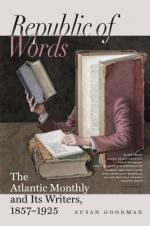But, pending this inevitable decline in favor at home, Pre-Raphaelitism colonizes. During the past year, some lovers of Art in England organized an association, having as its purpose the introduction of English Art to the American public,—partly, it was to be expected, with the view of opening this El Dorado to the English painter, but still more with the desire to extend the knowledge of what was to them a new and important revelation of Art. In its inception the plan was almost exclusively Pre-Raphaelite, but extended itself, on after-consideration, so far as to admit the worthiest artists of the conventional stamp. We have the first fruits of the undertaking in an exhibition which has achieved a success in New York, and which will probably visit the principal cities of the Union before its return home in the spring to make way for a second which will open in the autumn.
It is not as a collection of pictures merely that we purpose to notice this exhibition. Out of nearly four hundred pictures, the great proportion are mere conventionalisms,—many of them choice, but most of them in no wise to be compared with the pictures of the same class by French and German painters, since neither just drawing nor impressive color redeems their inanity of conception. There are some curious water-color drawings by Lance, remarkable mainly as forcibly painted, some exquisite color-pieces by William Hunt, and a number of fine examples of the matter-of-fact common-place which forms the great mass of pictures in the London exhibitions. Two drawings deserve especial, though brief, notice; one a coast bit by Copley Fielding,—a sultry, hazy afternoon on the seashore, where sea and sky, distance and foreground, are fused into one golden, slumberous silence, in which neither wave laps nor breeze fans, and only the blinding sun moves, sinking slowly down to where heaven and ocean mingle again in a happy dream of their old unity before the waters under the firmament were divided from the waters above the firmament, and the stranded ships lie with sails drooping and listless on a beach from which the last tide seems to have ebbed, leaving the ooze glistening and gleaming in the sunlight,—a picture of rare sentiment and artistic refinement;—the other is a waterfall by Nesfield,—a dreamy, careless, wayward plunge of waters over ledge after ledge of massive rock, the merry cascade enveloping itself in a robe of spray and mist, on the skirt of which flashes the faintest vision of a rainbow, which wavers and flits, almost, as you look at it, while the jets of foam plash up from the pool at the foot of the fall, a tranquil pause of the waters in a depth of uncertain blue, in which a suggestion of emerald flashes, and from which they dance on in less frantic mood over the brown and water-worn boulders to follow their further whims; everything that is most charming and spirituelle in the water-fall is given, and with a delicacy of color and subtilty of execution




